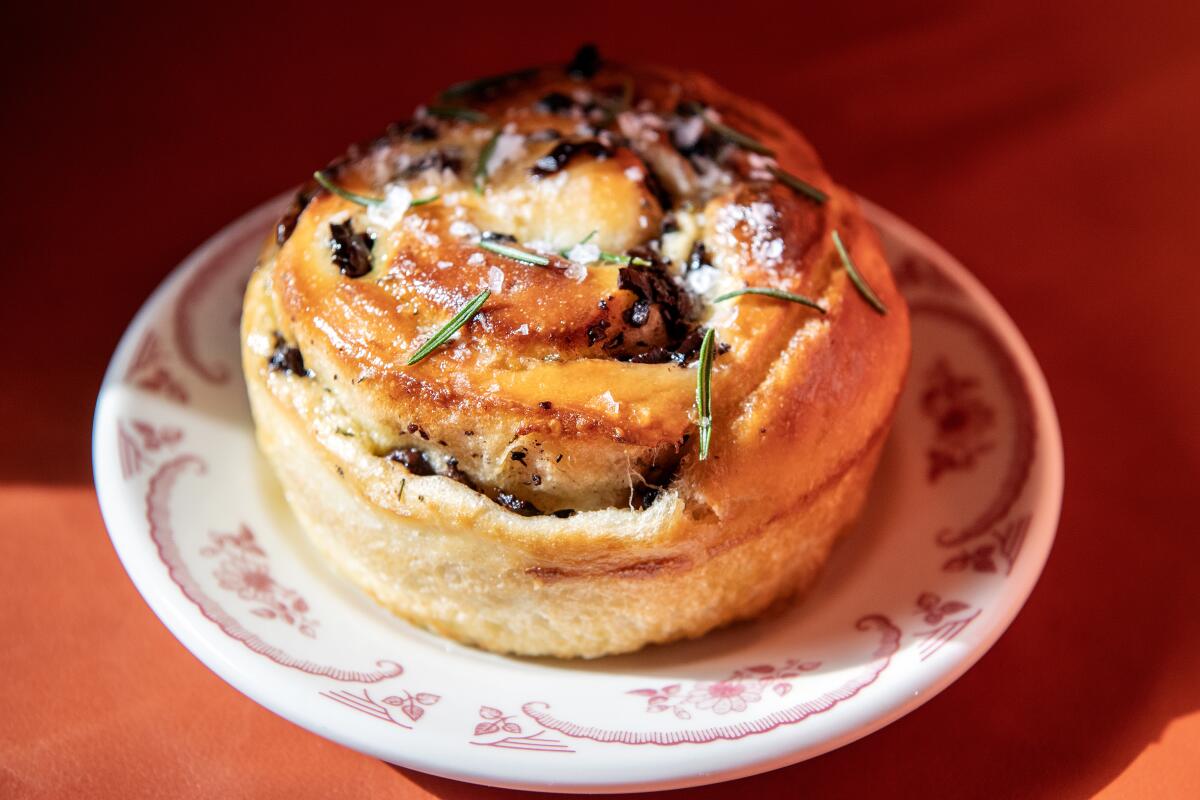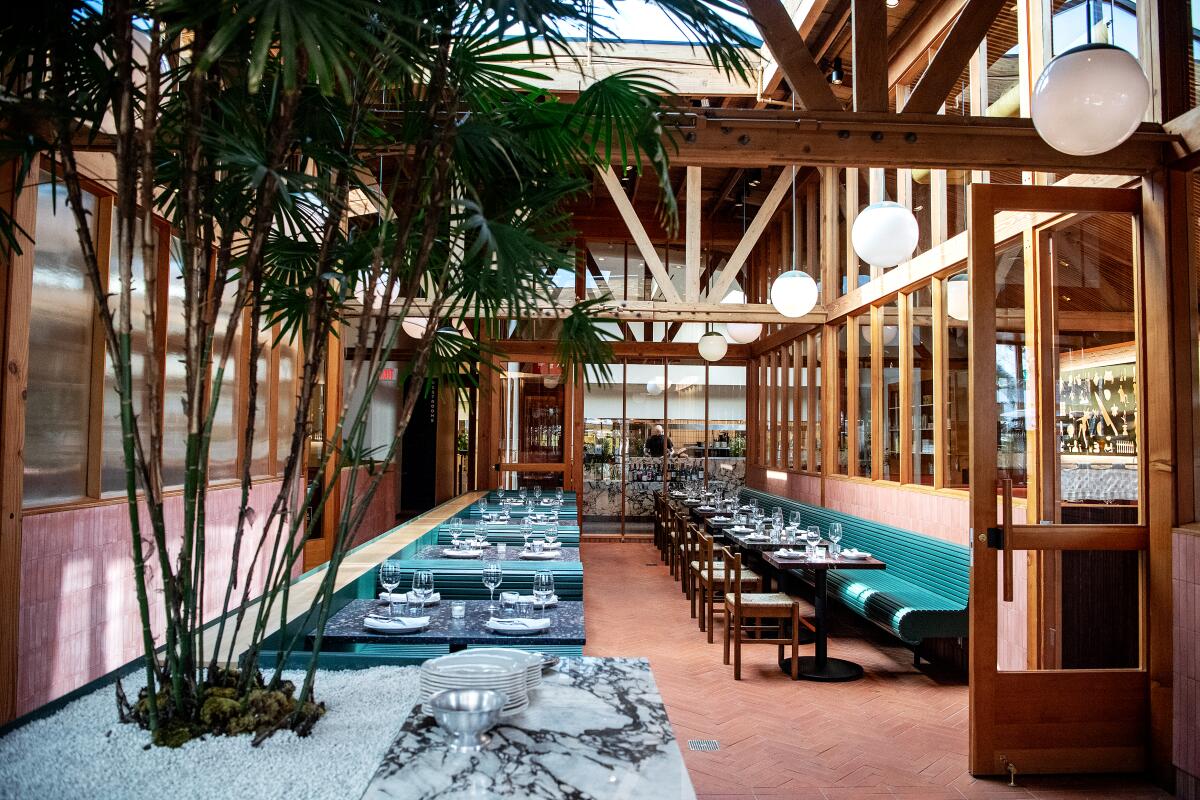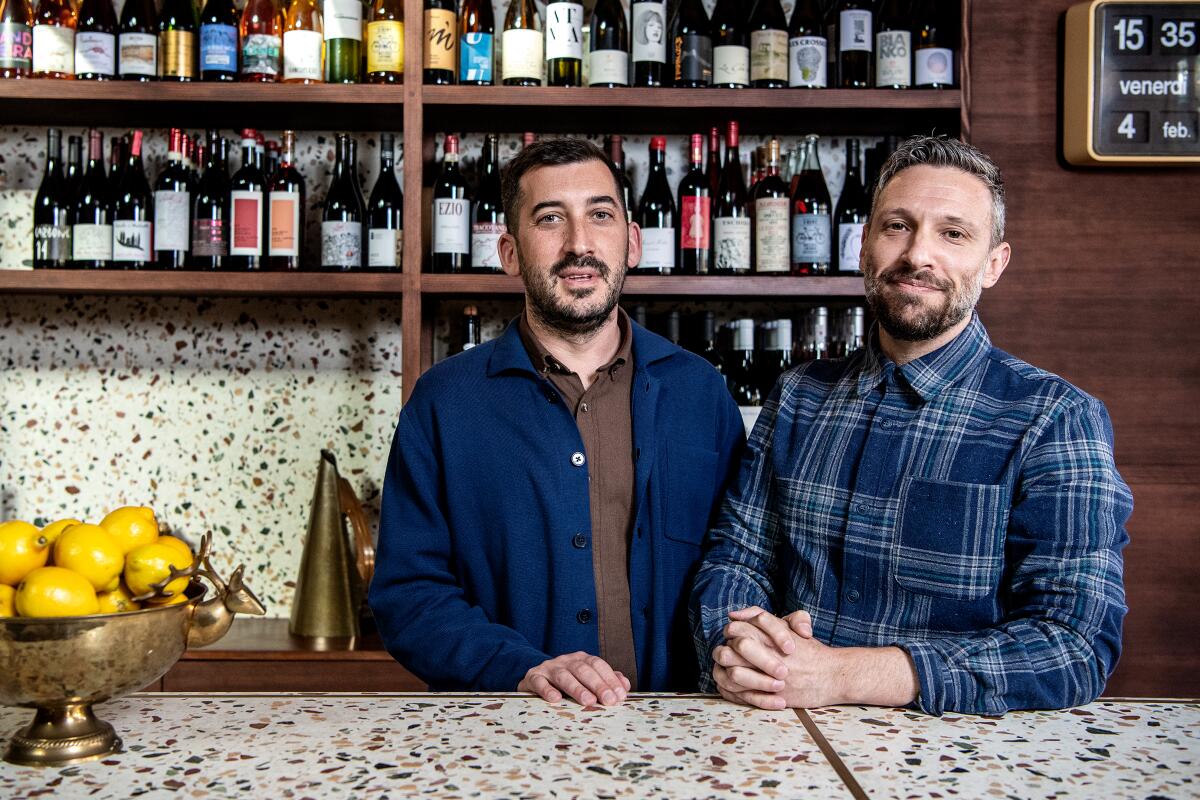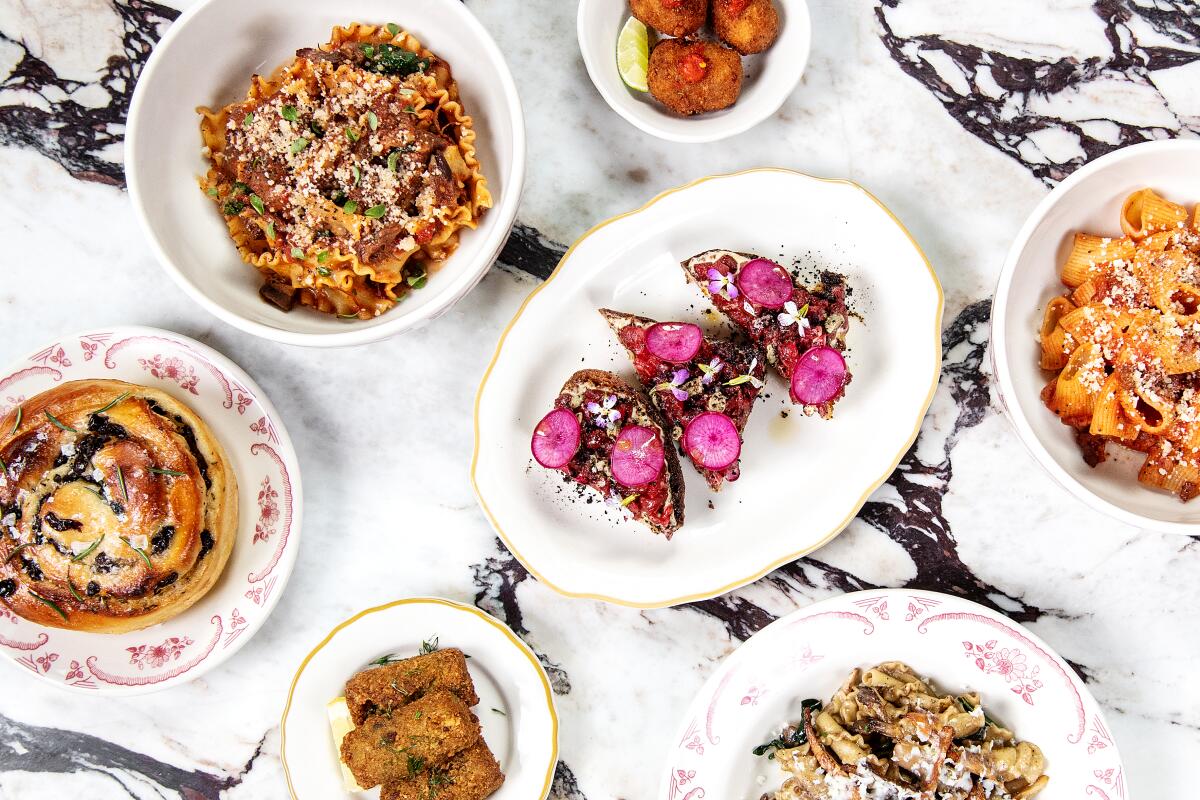Review: Bacetti in Echo Park stands apart with a gorgeous room and a Roman lilt

- Share via
In the upper righthand corner of the menu at Bacetti, floating just above descriptions of seasonal salads and the focaccia with olives and currants seen on nearly every table, take note of the centuries-old saying: “Rome wasn’t built in a day.” It’s been adopted as a tongue-in-cheek slogan, referring not only to the cuisine that informs the restaurant’s cooking but also the five-year odyssey that owners Jason Goldman and Christian Stayner endured to open their place.
Goldman, an art historian who comes from a line of restaurateurs, is finally heeding the call of the family business in his mid-40s. Stayner is an architect who leads a firm whose projects include a mezcaleria in San Clemente and the renovation of a 25-room hotel in Independence, Calif. The overhaul of their own project — the pair are partners in business and in life — began in 2016.
They stripped a circa-1928 building, set on an otherwise residential block of Echo Park Avenue near the neighborhood’s busy intersection known as “Chicken Corner,” down to its walls and bowstring truss ceiling. Stayner and his crew retained the bridgelike span of Douglas fir beams overhead, installed a partially glassed-in roof and created a uniquely airy space divided into sections by interior wood-framed windows.

Amid billows of red tape and construction delays, Goldman and Stayner decided to precede Bacetti by wading in with Tilda, a charming sliver of a wine bar occupying the building’s left corner. Echo Park neighbors immediately mobbed its few tables and its standing-only counter — at least for the six weeks it was open before the March 2020 shutdowns. Tilda stayed afloat as a wine shop and market until diners could flock back to its scattering of outdoor tables.
After nearly two years of pandemic-related setbacks, Bacetti finally came to life in November, brimming with elegant details: pine-green, wood-slatted benches and handsomely timeworn chairs with woven rush seats; curving booths upholstered in orange leather; speckled, charcoal-toned terrazzo floors that combine materials from California and Italy; and white marble counters thick with veining that’s the color of milk chocolate. The eyes can’t help but gaze into the centerpiece art installation from photographer Matt Lipps, two backlit brass panels with shapes cut out to resemble kitchen tools, people, palm trees and other forms that conjure a whirling urban ecology.

Even the ersatz alfresco dining setup was given some extra thought: Diners settle into a plywood structure, almost like a deep dugout, with pale yellow curtains on one side to muffle the street noise and plenty of space heaters to stave off L.A.’s evening chill.
I linger over the design both because it’s brilliant — the room gives the effect of a Shaker meetinghouse deconsecrated into a Modernist set piece — and there’s nothing else quite like it in the city, but also because it answers an essential question about Bacetti: What separates it from the scores of Italian restaurants that riddle our dining landscape?
The strength of the kitchen team, led by Joel Stovall, gives Bacetti an edge too.
Goldman and Stayner initially aimed to create a trattoria as true to the Roman canon as possible. Stovall — who was previously at downtown’s Il Fiore and who spent five years with Josef Centeno at the experimental, ever-wonderful Orsa & Winston — leaned into an Angeleno ethos, favoring a more expansive survey of Italian cuisine that leaves room for innovation.
Which brings us to the restaurant’s star-turn focaccia. It reimagines pizza ebraica, the cakey confection enfolded with raisins, candied fruits and nuts that’s a specialty of Rome’s Jewish bakeries. Bacetti’s version doesn’t exactly channel the original, but it is a pleasure entirely on its own terms, a savory-sweet spiral of dough rolled with chopped black olives, currants and rosemary and baked into individual rounds. Its caramelized crust splinters satisfyingly as you yank off soft layers.

I respect the permissive creativity, but I gravitate first to the handful of Roman dishes in their most familiar guises. Appetizers include suppli, the street snacks of fried rice balls typically filled with meats and mozzarella. (I love that the Romans cling to the analog nickname “suppli al telefono,” since the strings of cheese that stretch as you pull the croquettes apart were thought to resemble telephone lines.) Some suppli here come with minced rib-eye and peppers and others with the traditional addition of chicken gizzards (mild, with pleasant give to the texture); spinach and basil dye a vegetarian riff jade green inside. They’re all worth trying. Add an order of beef tartare bruschetta with head-clearing mustard aioli, and you have a strong start to dinner.
Roman-style gnocchi forgo potatoes in favor of a semolina-flour-based dough pressed into circles, arranged in an overlapping ring and baked in a sauce enriched with Parmigiano-Reggiano. This one is textbook, served in a smaller portion nearly enough to qualify as a pasta course — but also excellent as a side to the bistecca (dry-aged rib-eye served sliced with nicely sharp salsa verde) that is large enough to feed three or four as a main course.
Pastas fall into the feel-good category. Two takes on Roman classics, rigatoni all’amatriciana and tonnarelli alla carbonara, have the requisite presence of guanciale, though they lack the pork jowl’s barnyard-y wallop that you never forget the first time you inhale a twirled forkful of either dish in their birthplace. Still, these are happy-making renditions: You wolf them down, you melt into contentment, you take another sip of the mind-opening wine — say, a Puglian rosé so crisp and cherry-bright that it drinks like a deeper red — that beverage director Christian Clarke helps you choose. Same goes for mafaldine (ridged like the edge of lasagna noodles) that snare an appealing light short rib ragu, and for the bell-shaped campanelle mingling with a mix of mushrooms and ricotta salata.

Vegetables revolve with the market, and Stovall treats them with reverent imagination. Winter means roasted kabocha squash dressed with crème fraîche, hazelnuts and tart saba; a gratin of greens and pecorino baked in cream that’s mulchy and cheesy in all the right ways; and puntarelle paired with hearts of palm, dotted with grapefruit segments and (the only element most Romans would recognize) a garlicky anchovy vinaigrette.
My favorite dessert on the current menu follows the seasonal thread: Stovall rethinks ciambellone, an Italian tea cake often scented with lemon zest, into a flourless olive oil and almond cloud. He uses Cara Cara oranges that he pressure-cooks whole with sweet spices before whizzing them in a blender and then folding them into the cake batter. Eating it is akin to having a few extra minutes of sun on your face during short winter days.
Goldman mentioned to me that the ciambellone will likely appear during the restaurant’s forthcoming brunch service. Brunch here makes sense for the neighborhood. Even at night, whether you’re sitting inside or outside, the restaurant is part of the cityscape. Joggers, strolling families and people walking dogs flow past diners sitting at sidewalk tables or waiting their turn at the host stand just inside the door. The scene is organic and calming. Bacetti has been years in the making, but already it feels like it’s been around forever.
Bacetti
1509 Echo Park Ave., (213) 995-6090, bacetti-la.com
Prices: Starters and salads $6-$18, small plates $8-$21, pastas $18-$28, pizzas $18-$22, meat and fish dishes $35-$90, desserts $9-$10
Details: Dinner Tues.-Sun. 5-10 p.m. Wine. Credit cards accepted. Street parking.
Recommended dishes: suppli al telefono, focaccia ebraica, gnocchi alla Romana, verdura gratin, mafaldine with short rib ragu, bistecca, ciambellone
More to Read
Eat your way across L.A.
Get our weekly Tasting Notes newsletter for reviews, news and more.
You may occasionally receive promotional content from the Los Angeles Times.










